Citroen BERLINGO MULTISPACE RHD 2014.5 2.G Owner's Manual
Manufacturer: CITROEN, Model Year: 2014.5, Model line: BERLINGO MULTISPACE RHD, Model: Citroen BERLINGO MULTISPACE RHD 2014.5 2.GPages: 276, PDF Size: 12.15 MB
Page 151 of 276

Berlingo_2_VP_en_Chap07_Verification_ed02-2014
 149
AdBLuE® AddItIVE
A
nd S
cr
SYS t EM
FO
r B
L
u
E H dI dIESEL
E
n
GI
n
ES
To assure respect for the environment and  conformity  with  the  new  Euro  6 Â
emissions
 standard,  without  adversely Â
af
fecting  the  performance  or  fuel Â
consumption
 of  Diesel  engines, Â
CITROĂ‹N
 has  taken  the  decision  to Â
equip
 its  vehicles  with  an  effective Â
system
 that  associates  SCR  (Selective Â
Catalytic Reduction) with a particle
filter
 (FAP)  for  the  treatment  of  exhaust Â
gases.
Presentation of the Scr system
Using an additive called adBlue®
containing urea, a catalytic converter
turns up to 85% of nitrous oxides
(
no
x) into nitrogen and water, which
are
Â
harmless
Â
to
Â
health
Â
and
Â
the
Â
environment.
The
a
dBlue
® additive is held in a
special
Â
tank
Â
located  under  the  boot Â
at
Â
the
Â
rear
Â
of  the  vehicle.  It  has  a Â
capacity
Â
of
Â
17  litres:  this  provides  a Â
driving
Â
range  of  about  12  500  miles Â
(20
Â
000 km),  after  which  an  alert Â
is triggered warning you when the
reserve
Â
remaining  is  enough  for  just Â
1
Â
500
Â
miles
Â
(2 Â 400 Â km).
d
uring each scheduled service of
your vehicle by a CITR
o Ă‹ n dealer
or
Â
a
Â
qualified  workshop,  the Â
AdBlue®
additive
Â
tank
Â
is
Â
refilled
Â
in
Â
order
Â
to
Â
allow Â
normal
Â
operation
Â
of
Â
the
Â
SCR
Â
system.
If
Â
the
Â
estimated
Â
mileage
Â
between
Â
two services is greater than
12Â 500Â miles
Â
(20
Â
000
Â
km),
Â
we
Â
recommend
Â
that
Â
you
Â
go
Â
to
Â
a
Â
CITROĂ‹N Â
dealer
Â
or
Â
a
Â
qualified
Â
workshop
Â
to
Â
have Â
the
Â
necessary
Â
top-up
Â
carried
Â
out.
o
nce the a dBlue
® tank is empty, a
Â
system
Â
required  by  regulations Â
prevents
Â
starting
Â
of  the  engine.
If the SCR
is faulty, the level of
emissions
Â
from
Â
your
Â
vehicle  will  no Â
longer
Â
meet
Â
the
Â
Euro
Â
6 Â standard: Â you Â
vehicle
Â
becomes
Â
polluting.
In
Â
the
Â
event
Â
of
Â
a
Â
confirmed  fault Â
with
Â
the
Â
SCR
Â
system,
Â
you  must  go Â
to
Â
a
Â
CITROĂ‹N
Â
dealer
Â
or  a  qualified Â
workshop
Â
as
Â
soon
Â
as
Â
possible: Â after Â
a
Â
running
Â
distance
Â
of
Â
650 Â miles Â
(1
Â
100
Â
km),
Â
a
Â
system
Â
will  be  triggered Â
automatically
Â
to
Â
prevent  engine Â
starting.
AdBlue® additive
cHEcKS
7
Page 152 of 276
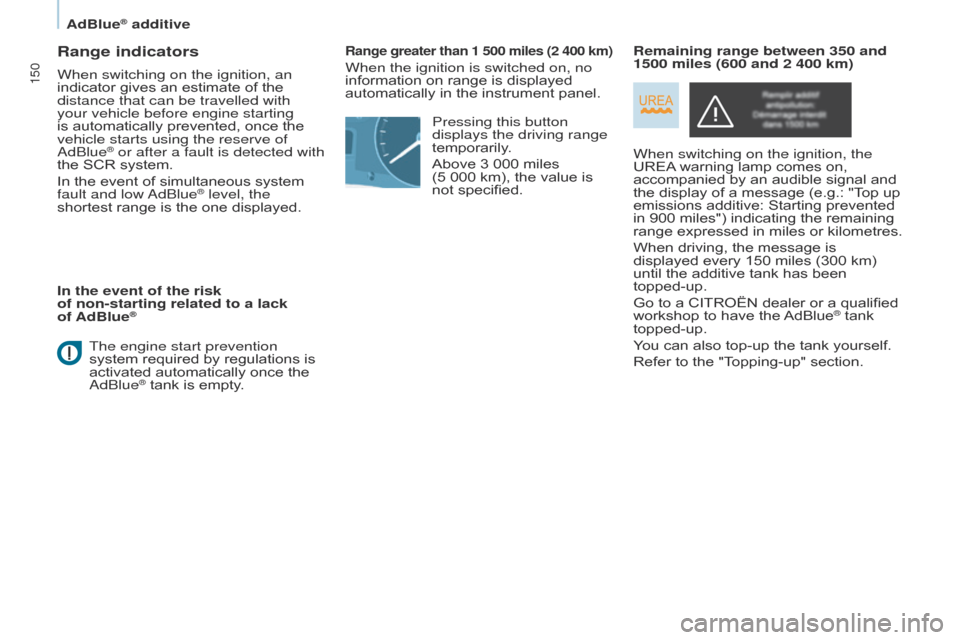
Berlingo_2_VP_en_Chap07_Verification_ed02-2014
150
range indicators
When switching on the ignition, an
indicator gives  an  estimate  of  the Â
distance that can be travelled with
your vehicle before engine starting
is
 automatically  prevented,  once  the Â
vehicle starts using the reserve of a
dBlue
® or after a fault is detected with
the
Â
SCR Â system.
In
Â
the
Â
event  of  simultaneous  system Â
fault and low a
dBlue
® level, the
shortest
Â
range
Â
is
Â
the
Â
one  displayed.
In the event of the risk
of non-starting related to a lack
of AdBlue
®
The engine start prevention
system  required  by  regulations  is Â
activated
 automatically  once  the Â
a
dBlue
® tank is empty.
range greater than 1 500 miles (2 400 km)
When the ignition is switched on, no
information  on  range  is  displayed Â
automatically
 in  the  instrument  panel.
Pressing this button
displays the driving range
temporarily.
Above
 3  000  miles Â
(5
 000  km),  the  value  is Â
not
 specified. When switching on the ignition, the
UREAÂ warning
 lamp  comes  on, Â
accompanied
 by  an  audible  signal  and Â
the
 display  of  a  message  (e.g.:  "Top  up Â
emissions
 additive:  Starting  prevented Â
in
 900  miles")  indicating  the  remaining Â
range
 expressed  in  miles  or  kilometres.
When
 driving,  the  message  is Â
displayed
 every  150  miles  (300  km) Â
until
 the  additive  tank  has  been Â
topped-up.
Go
 to  a  CITROĂ‹N  dealer  or  a  qualified Â
workshop
 to  have  the Â
AdBlue® tank topped-up.
Y
ou
Â
can
Â
also
Â
top-up
Â
the
Â
tank
Â
yourself.
Refer
Â
to
Â
the
Â
"Topping-up"
Â
section.
r
emaining range between 350 and
1500 miles (600 and 2 400 km)
adBlue® additive
Page 153 of 276
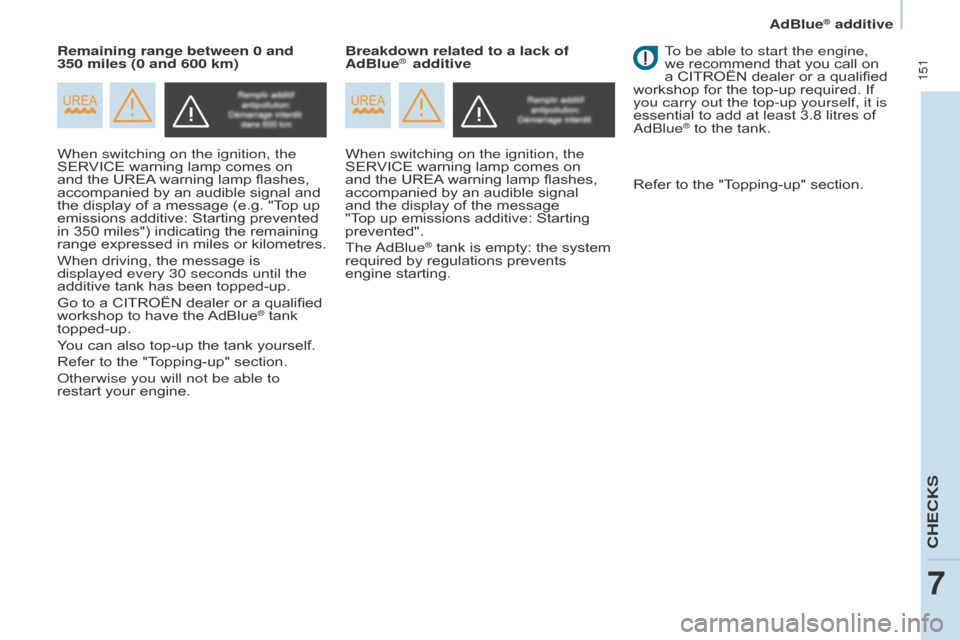
Berlingo_2_VP_en_Chap07_Verification_ed02-2014
151
When switching on the ignition, the
SERVICE warning  lamp  comes  on Â
and
 the  UREA
Â
warning  lamp  flashes, Â
accompanied
 by  an  audible  signal  and Â
the
 display  of  a  message  (e.g.  "Top  up Â
emissions
 additive:  Starting  prevented Â
in
 350  miles")  indicating  the  remaining Â
range
 expressed  in  miles  or  kilometres.
When
 driving,  the  message  is Â
displayed every 30 seconds until the
additive
 tank  has  been  topped-up.
Go
 to  a  CITROĂ‹N  dealer  or  a  qualified Â
workshop
 to  have  the Â
AdBlue® tank topped-up.
Y
ou
Â
can
Â
also
Â
top-up
Â
the
Â
tank
Â
yourself.
Refer
Â
to
Â
the
Â
"Topping-up"
Â
section.
o
therwise you will not be able to
restart
Â
your
Â
engine. When switching on the ignition, the
SERVICE
 warning  lamp  comes  on Â
and
 the  UREA
Â
warning  lamp  flashes, Â
accompanied
 by  an  audible  signal Â
and
 the  display  of  the  message Â
"T
op  up  emissions  additive:  Starting Â
prevented".
The
a dBlue
® tank is empty: the system required
Â
by
Â
regulations  prevents Â
engine
Â
starting. To be able to start the engine,
we
 recommend  that  you  call  on Â
a
 CITROĂ‹N  dealer  or  a  qualified Â
workshop
 for  the  top-up  required.  If Â
you carry out the top-up yourself, it is
essential
 to  add  at  least  3.8  litres  of Â
a dBlue
® to the tank.
r
emaining range between 0 and
350 miles (0 and 600 km) Breakdown related to a lack of
AdBlue
® additive
Refer  to  the  "Topping-up"  section.
adBlue® additive
CHECkS
7
Page 154 of 276
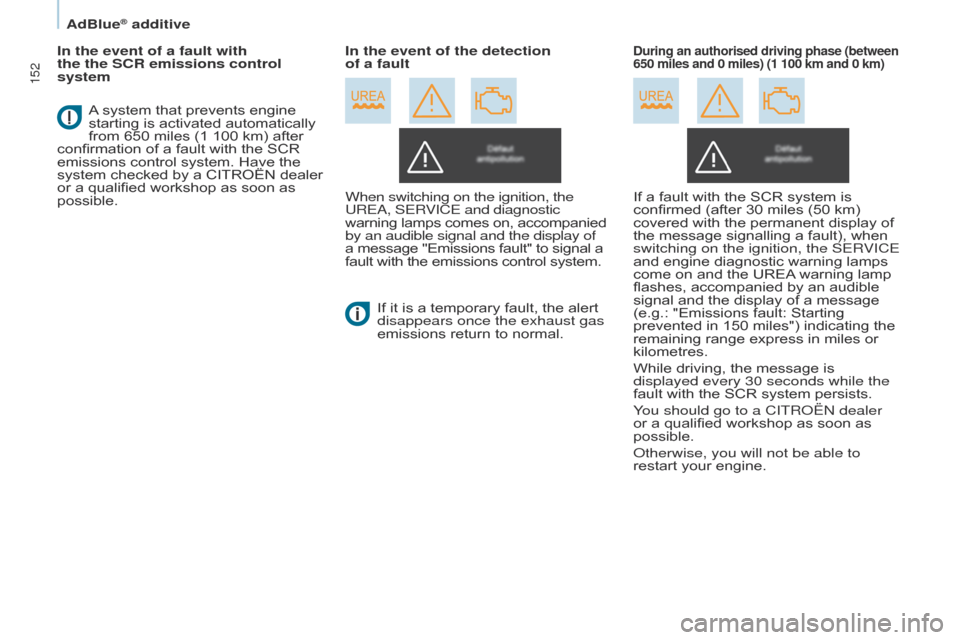
Berlingo_2_VP_en_Chap07_Verification_ed02-2014
152
In the event of a fault with
the the Scr emissions control
system
When switching on the ignition, the
URE
a , SERVICE and diagnostic
warning
 lamps  comes  on,  accompanied
 by an audible signal and the display of
a
 message  "Emissions  fault"  to  signal  a
 fault
 with  the  emissions  control  system.
If
 it  is  a  temporary  fault,  the  alert Â
disappears once the exhaust gas
emissions
 return  to  normal.during an authorised driving phase (between
650 miles and 0 miles) (1 100 km and 0 km)
A system  that  prevents  engine  starting
 is  activated  automatically Â
from
 650  miles  (1  100  km)  after Â
confirmation
 of  a  fault  with  the  SCR Â
emissions
 control  system.  Have  the Â
system
 checked  by  a  CITROĂ‹N  dealer Â
or
Â
a
Â
qualified  workshop  as  soon  as Â
possible. In the event of the detection
of a fault
If  a  fault  with  the  SCR  system  is Â
confirmed
 (after  30  miles  (50  km) Â
covered
 with  the  permanent  display  of Â
the
 message  signalling  a  fault),  when Â
switching on the ignition, the SER
VICE
and
 engine  diagnostic  warning  lamps Â
come
 on  and  the  UREA
Â
warning  lamp Â
flashes,
 accompanied  by  an  audible Â
signal
 and  the  display  of  a  message Â
(e.g.:
 "Emissions  fault:  Starting Â
prevented
 in  150  miles")  indicating  the Â
remaining
 range  express  in  miles  or Â
kilometres.
While
 driving,  the  message  is Â
displayed every 30 seconds while the
fault
 with  the  SCR  system  persists.
You should go to a CITR
o Ă‹ n dealer
or
 a  qualified  workshop  as  soon  as Â
possible.
o
therwise, you will not be able to
restart
 your  engine.
adBlue® additive
Page 155 of 276
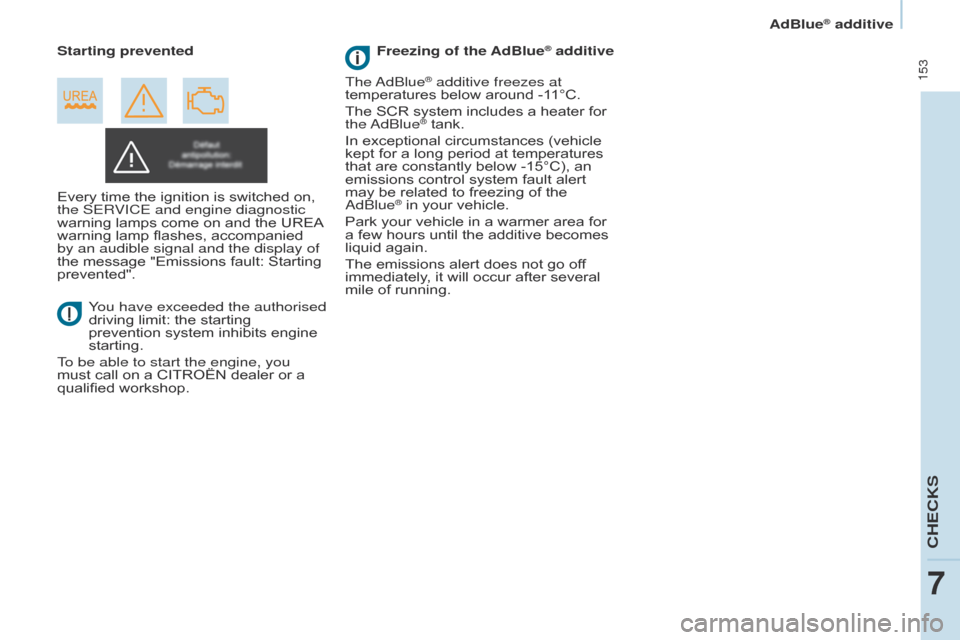
Berlingo_2_VP_en_Chap07_Verification_ed02-2014
153
Every time the ignition is switched on, the SERVICE and engine diagnostic
warning
 lamps  come  on  and  the  UREA
 warning
 lamp  flashes,  accompanied Â
by an audible signal and the display of
the
 message  "Emissions  fault:  Starting Â
prevented".
Y
ou have exceeded the authorised
driving
 limit:  the  starting Â
prevention
 system  inhibits  engine Â
starting.
T
o be able to start the engine, you
must
 call  on  a  CITROĂ‹N  dealer  or  a Â
qualified
 workshop.
Starting prevented
The a dBlue
® additive freezes at
temperatures  below  around  -11°C.
The
Â
SCR
Â
system  includes  a  heater  for Â
the
a
dBlue
® tank.
In
Â
exceptional  circumstances  (vehicle Â
kept
Â
for
Â
a
Â
long  period  at  temperatures Â
that
Â
are
Â
constantly  below  -15°C),  an Â
emissions
Â
control  system  fault  alert Â
may
Â
be
Â
related  to  freezing  of  the Â
a
dBlue
® in your vehicle.
Park
Â
your  vehicle  in  a  warmer  area  for Â
a
Â
few
Â
hours  until  the  additive  becomes Â
liquid
Â
again.
The
Â
emissions  alert  does  not  go  off Â
immediately
,  it  will  occur  after  several Â
mile
Â
of
Â
running.
Freezing of the AdBlue
® additive
adBlue® additive
CHECkS
7
Page 156 of 276

Berlingo_2_VP_en_Chap07_Verification_ed02-2014
154
topping-up the AdBlue® additive
Filling the adBlue® tank is an operation included in every routine service on
your vehicle by a CITR
o Ă‹ n dealer
or
Â
a
Â
qualified
Â
workshop.
n
evertheless, given the capacity
of
Â
the
Â
tank,
Â
it
Â
may
 be  necessary  to Â
top-up the additive between services,
more
Â
particularly
Â
if  an  alert  (warning Â
lamps
Â
and
Â
a
Â
message)  signals  the Â
requirement.
Y
ou can got to a CITR o Ă‹ n dealer
or
Â
a
Â
qualified
Â
workshop.
If you envisage topping-up yourself,
please read the following warnings
carefully. Precautions in use
The
a dBlue® additive is an urea-based
solution.
 This  liquid  is  non-flammable, Â
colourless
Â
and  odourless  (kept  in  a Â
cool
Â
area).
In
Â
the
Â
event
Â
of  contact  with  the  skin, Â
wash the af
fected area with soap and
water.
Â
In
Â
the
 event  of  contact  with  the Â
eyes, wash (irrigate) the eyes with
large
Â
amounts  of  water  or  with  an  eye Â
wash
Â
solution  for  at  least  15  minutes. Â
If a burning sensation or irritation
persists,
Â
get
 medical  attention.
If
Â
swallowed,  immediately  wash  out  the Â
mouth
Â
with
Â
clean  water  and  then  drink Â
plenty
Â
of
Â
water.
In
Â
certain
Â
conditions  (high  ambient Â
temperature,
 for  example),  the  risk Â
of
Â
release
Â
of
 ammonia  cannot  be Â
excluded:
Â
do  not  inhale  the  product. Â
Ammonia
Â
vapour  has  en  irritant  effect Â
on
Â
mucous
Â
membranes  (eyes,  nose Â
and
Â
throat).
k
eep
a
dBlue
® out of the reach of
children,
Â
in
Â
its
 original  bottle.
n
ever transfer
a
dBlue
® to another
container:
Â
it
Â
would
Â
loose  its  purity. Use only
a dBlue
® additive that meets the
Â
ISO
Â
22241
Â
standard.
n
ever dilute the additive with
water.
n
ever pour the additive into the d iesel
fuel
Â
tank.
The supply in a non-drip bottle
simplifies
Â
toping-up. Â
Y
ou  can  obtain Â
1.89
Â
litre
Â
(half
Â
a
Â
US Â gallon) Â bottles Â
from
Â
a
Â
CITROĂ‹N dealer  or  a  qualified Â
workshop.Never
Â
top-up  from  an Â
AdBlue®
dispenser reserved for heavy
goods
Â
vehicles.
adBlue® additive
Page 157 of 276
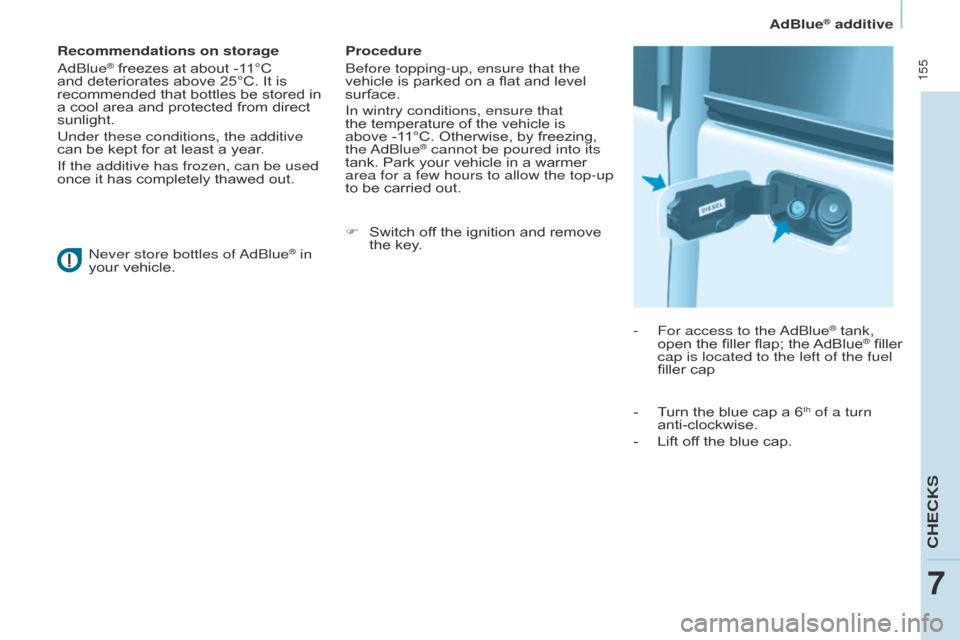
Berlingo_2_VP_en_Chap07_Verification_ed02-2014
155
recommendations on storage
a
dBlue® freezes at about -11°C and
Â
deteriorates  above  25°C.  It  is Â
recommended
 that  bottles  be  stored  in Â
a
Â
cool
Â
area  and  protected  from  direct Â
sunlight.
Under these conditions, the additive
can
Â
be
Â
kept  for  at  least  a  year.
If the additive has frozen, can be used
once
Â
it
Â
has  completely  thawed  out.
n
ever store bottles of
a
dBlue
® in
your
Â
vehicle. Procedure
Before topping-up, ensure that the
vehicle
 is  parked  on  a  flat  and  level Â
surface.
In wintry conditions, ensure that
the
 temperature  of  the  vehicle  is Â
above -1
1°C.  Otherwise,  by  freezing, Â
the
a dBlue
® cannot be poured into its
tank.
Â
Park
Â
your  vehicle  in  a  warmer Â
area for a few hours to allow the top-up
to
Â
be
Â
carried  out.
F
Â
Switch
Â
off  the  ignition  and  remove Â
the
Â
key. -
For access to the a
dBlue
® tank, open
Â
the
Â
filler
Â
flap;
Â
the
 AdBlue® filler cap is located to the left of the fuel
filler
Â
cap
-
Â
T
urn
Â
the
Â
blue
Â
cap
Â
a
Â
6
th of a turn
anti-clockwise.
-
Â
Lift
Â
off
Â
the
Â
blue
Â
cap.
adBlue® additive
CHECkS
7
Page 158 of 276
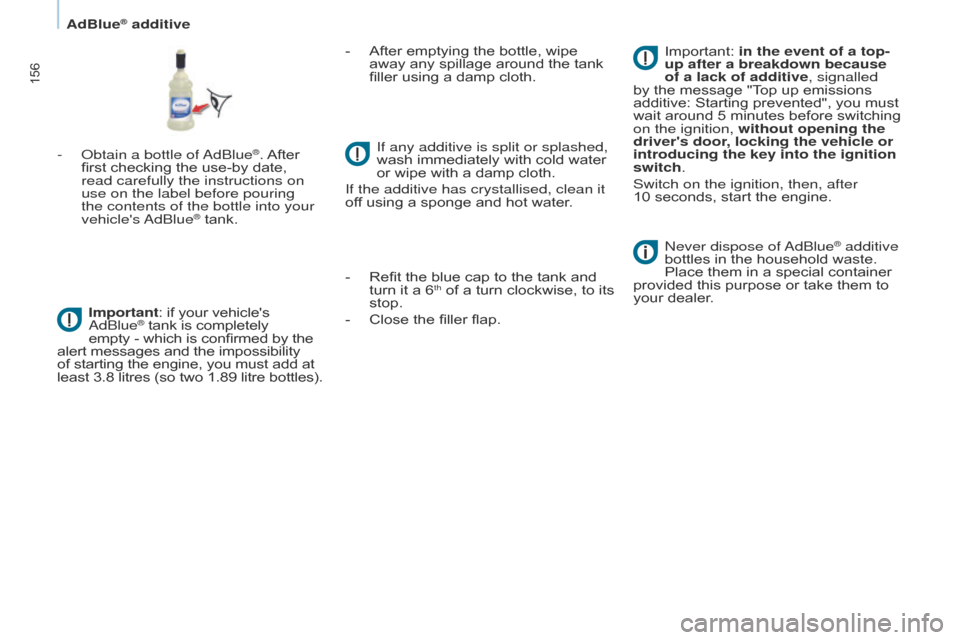
Berlingo_2_VP_en_Chap07_Verification_ed02-2014
156
- obtain a bottle of adBlue®. After first
Â
checking
Â
the
Â
use-by
Â
date, Â
read carefully the instructions on
use on the label before pouring
the contents of the bottle into your
vehicle's
a
dBlue
® tank.
Important
:
Â
if
Â
your  vehicle's
Â
a
dBlue
® tank is completelyÂ
empty
Â
-
Â
which  is  confirmed  by  the alert
Â
messages  and  the  impossibility
 of
Â
starting
Â
the  engine,  you  must  add  at
 least
Â
3.8
Â
litres  (so  two  1.89  litre bottles). -
Â
After
 emptying  the  bottle,  wipe Â
away
 any  spillage  around  the  tank Â
filler
 using  a  damp  cloth.
If any additive is split or splashed,
wash  immediately  with  cold  water Â
or
 wipe  with  a  damp  cloth.
If the additive has crystallised, clean it
off  using  a  sponge  and  hot  water.
- Â
Refit
 the  blue  cap  to  the  tank  and Â
turn
 it  a  6
th of a turn clockwise, to its stop.
-
Â
Close
Â
the
Â
filler  flap.
n
ever dispose of
a
dBlue
® additive
bottles
Â
in
Â
the
Â
household
Â
waste. Â
Place
Â
them
Â
in
Â
a
Â
special
Â
container Â
provided
Â
this
Â
purpose
Â
or
Â
take
Â
them  to Â
your
Â
dealer.
Important:
Â
in the event of a top-
up after a breakdown because
of a lack of additive, signalled
by
Â
the
Â
message
Â
"Top
Â
up
Â
emissions Â
additive:
Â
Starting
Â
prevented",
Â
you  must Â
wait
Â
around
Â
5
Â
minutes
Â
before
Â
switching Â
on the ignition,
without opening the
driver's door, locking the vehicle or
introducing the key into the ignition
switch.
Switch on the ignition, then, after
10
Â
seconds,
Â
start
Â
the
Â
engine.
adBlue® additive
Page 159 of 276

157
Berlingo_2_VP_en_Chap08_aide-rapide_ed02-2014
BAttE rY
Before disconnecting the battery, you
must
 wait  for  2  minutes  after  switching Â
of
f  the  ignition.
Never
 disconnect  a  terminal  when  the Â
engine
 is  running.
Never
 charge  a  battery  without  first Â
disconnecting
 the  terminals.
a
fter every reconnection of the battery,
switch
 on  the  ignition  and  wait  1  minute Â
before starting to allow the electronic
systems
 to  be  initialised.  If  problems Â
remain
 after  doing  this,  please  contact Â
a
 CITROĂ‹N  dealer  or  a  qualified Â
workshop.
a
fter changing bulbs, wait
approximately
 3  minutes  before Â
reconnecting
 the  battery.
It is advisable to disconnect the
battery if the vehicle is not to be
used
Â
for
Â
a
Â
period
Â
of
Â
more
Â
than
Â
one month.
to charge the battery using a
battery charger
- disconnect the battery,
-
Follow the instructions for use
given by the battery charger
manufacturer
,
-
Reconnect starting with the
negative
 (-)  terminal,
-
Â
Check
 that  the  terminals  and Â
connectors
 are  clean.  If  they  are Â
covered with sulphate (white or
greenish
 deposit),  disconnect  them Â
and
 clean  them.
to start the vehicle from
another battery
- Connect the red cable to the
positive  (+)  terminals  of  the Â
two
batteries,
-
Connect one end of the green
or
 black  cable  to  the  negative  (-) Â
terminal
 of  the  slave  battery,
-
Connect the other end of the green
or
 black  cable  to  an  earth  point  on Â
the
 broken  down  vehicle  as  far  as Â
possible
 from  the  battery,
-
o perate the starter, let the engine run,
-
W
ait for the engine to return to idle,
then
 disconnect  the  cables.
The presence of this label
indicates the use of a 12 V
lead-acid battery with special
technology
Â
and
Â
specification,
Â
for
Â
which
Â
the
Â
involvement
Â
of
Â
a
Â
CITROĂ‹N
Â
dealer
Â
or
Â
qualified
Â
workshop
Â
is
Â
required
Â
when
Â
replacing
Â
or
Â
disconnecting
Â
the
Â
battery.
Failure to observe this
recommendation
Â
may
Â
cause
Â
premature
 wear
Â
of
Â
the
Â
battery.
After
Â
refitting
Â
the
Â
battery,
Â
the
Â
Stop &
Â
Start
Â
system
Â
will
Â
only
Â
be
Â
active
Â
after
Â
several hours depending on the
climatic
Â
conditions
Â
and
Â
the
Â
state
Â
of
Â
charge of the battery (up to about
8Â hours).
The Stop & Start battery does not have
to
Â
be
Â
disconnected
Â
for
Â
charging.
Battery
QUICk HELP
8
Page 160 of 276

158
Berlingo_2_VP_en_Chap08_aide-rapide_ed02-2014
EcOnOMY MOdE
after the engine has stopped, with
the  key  in  the  ignition  position,  certain Â
functions (windscreen wiper
, electric
windows,
 courtesy  lamps,  audio Â
equipment,
 etc.)  can  only  be  used  for  a Â
cumulative
 duration  of  thirty  minutes, Â
to
 prevent  discharging  of  the  battery.
Once
 the  thirty  minutes  are  over,  the Â
active functions are put on standby
and
 the  battery  warning  lamp  flashes Â
accompanied
 by  a  message  in  the Â
screen.
T
o  resume  the  use  of  these  functions Â
immediately
,  start  the  engine  and  let  it Â
run
 for  a  few  minutes.
The
 time  available  will  then  be  double Â
the
 time  for  which  the  engine  was  left Â
running.
 However,  this  time  will  always Â
be
 between  five  and  thirty  minutes.
A
Â
flat  battery  will  prevent  the Â
engine
 from  starting.
Battery